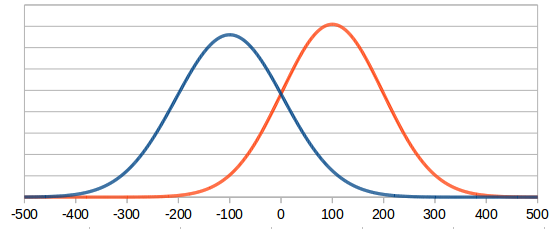These are the results from the Multidimensional Introversion-Extraversion Scales. Scores on the MIES range between -500 and +500 and are adjusted so that the average score for self identified introverts is -100 and the average score for self identified extraverts is +100 for each of the different scales.
Overall score
Your score for overall Introversion-Extraversion was was . The distributions of how self identified introverts (blue) and self identified extraverts (red) score are shown below.

There is a lot of overlap in the middle, which seems may seem strange given that introverts and extroverts are usually considered be different categories. Shouldn't all extraverts get a higher score than all introverts? The reason for this overlap is differences in what definitions people are using to decide if they are introverts or extraverts. For example one person who has social anxiety but likes dancing at the club might consider themselves an introvert because they believe that introversion-extraversion is about how good/confident you feel when interacting with people, while a second person with those same traits might consider themselves an extrovert because they think that introversion-extraversion is about how often you leave your house to be around people. There is no one correct definition of I-E, only definitions that are more or less similar to the average definition. Every question on this test was selected because self identified introverts and extroverts answer them differently on average.